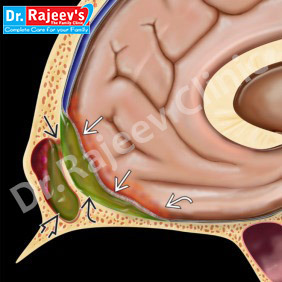

Empyema is also called pyothorax or purulent pleuritis. It is a condition in which pus gathers in the area between the lungs and the inner surface of the chest wall. This area is known as the pleural space. Pus is a fluid that is filled with immune cells, dead cells, and bacteria. Pus in the pleural space can not be coughed out.
Empyema usually develops after pneumonia, which is an infection of the lung tissue.
Empyema can develop after having pneumonia. Many different types of bacteria may cause pneumonia, but the two most common are Streptococcus pneumoniae and Staphylococcus aureus. Occasionally, empyema may happen after surgery in chest. Medical instruments can transfer bacteria into pleural cavity.
The pleural space naturally has some fluid, but infection can cause fluid to build up faster than it can be absorbed. The fluid then becomes infected with the bacteria that caused the pneumonia or infection. The infected fluid thickens. It can cause the lining of lungs and chest cavity to stick together and form pockets. This is called an empyema.Lungs may not be able to inflate completely, which can lead to breathing difficulties.
The biggest risk factor for empyema is having pneumonia. Empyema occurs most frequently in children and older adults. However, it is fairly uncommon. In one study, it occurred in less than 1 percent of children with pneumonia.
Having the following conditions can also increase our chances of empyema after pneumonia:
Empyema can be simple or complex.
Simple empyema occurs in the early stages of the illness. A person has this type if the pus is free-flowing. The symptoms of simple empyema include:
Complex empyema occurs in the later stage of the illness. In complex empyema, the inflammation is more severe.Scar tissue may form and divide the chest cavity into smaller cavities.This is called loculation, and it is more difficult to treat.
If the infection continues to get worse, it can lead to the formation of a thick peel over the pleura, called a pleural peel. This peel prevents the lung from expanding. Surgery is required to fix it.
Other symptoms in complex empyema include:
In rare instances, a case of complex empyema can lead to more severe complications. These include sepsis and a collapsed lung, also called a pneumothorax. The symptoms of sepsis include:
A collapsed lung can cause sudden, sharp chest pain and shortness of breath that gets worse when coughing or breathing.